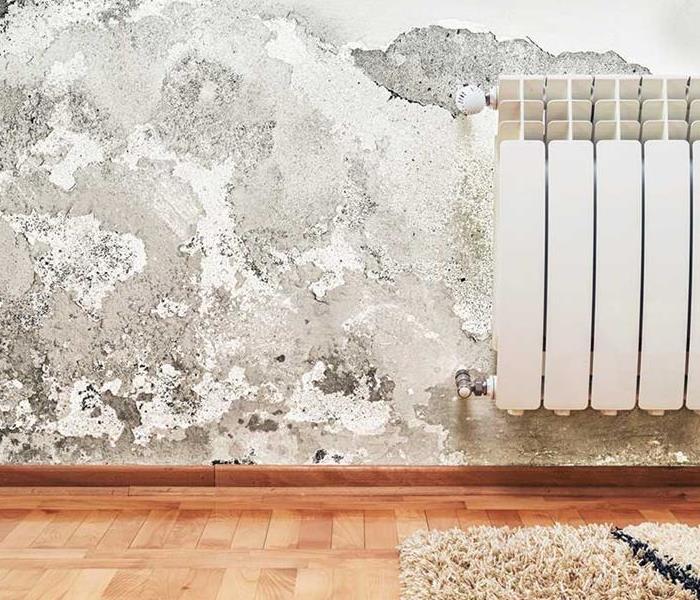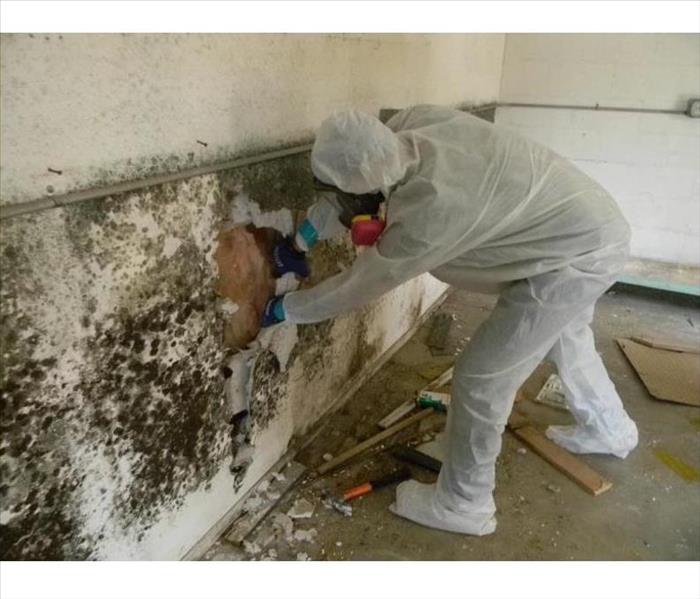Archived Mold Remediation Blog Posts
Types of Mold & its Concerns
9/1/2022 (Permalink)
Concerns with Mold
Mold spores are in the air everywhere. Inside, mold is at home in moist, dark places—like basements, bathrooms, and behind kitchen appliances—circulating via heating and air-conditioning systems. Outside, mold thrives in the woods, on fallen leaves and dead plants in the garden, and even on some grains and grasses.
Generally, mold and people can coexist without serious concerns. However, there are some groups that need to be concerned with possible problems that come with exposure to mold. The elderly and very young can be more vulnerable to adverse symptoms from mold exposure due to possible lower immunity to allergens, and those with respiratory conditions can be seriously affected when exposed to mold.
MOLD ALLERGY SYMPTOMS
Mold allergies can affect us all year long and bring on nasal allergy symptoms like nasal congestion, sneezing, runny nose, itchy nose, and itchy/watery eyes. And in serious cases, difficulty breathing.
TYPES OF MOLD THAT CAN CAUSE ALLERGIES:
BLACK MOLD
This type of mold tends to grow on building materials like fiberboard and gypsum board, and on paper, dust, and lint. Black mold growth is a result of excessive moisture from extreme humidity, flooding or other types of water damage.
SNOW MOLD
As the snow begins to melt in the spring and the ground warms up, the conditions become perfect for snow mold’s fungal spores to thrive. Snow mold comes in two varieties—grey and pink—and both can bring on nasal allergy symptoms.
LEAF MOLD
Piles of rotting leaves provide the ideal conditions for mold to thrive. Leaf mold generally goes dormant in the winter but begins growing as soon as the weather warms up in the spring.
When mold is discovered inside of a business or residence, SERVPRO of Glendora/San Dimas will be happy to provide a free inspection to help determine if mold is present and if so, propose steps to eliminate the cause and remove mold from the structure.
Where Mold Can Grow
11/28/2021 (Permalink)
Where Mold Can Grow:
There are a handful of areas of the house that mold can be found in your home or your commercial building space. It is important for the safety of your health, home and building to be familiar with the multiple areas mold can be found.
Any area of a home or a commercial building space that is prone to water, humidity, being damp or lack of ventilation is prone to mold growth.
Any area of the home or office building that has major appliances, those areas are especially susceptible to mold growth.
Ventilation ducts, carpets, furniture and crawl spaces are other places to be concerned for mold growth.
Always be aware of odd odors in these areas. They are almost a sure sign of mold.
If you are concerned about mold in your own home or office space, call Joe McCann at SERVPRO Glendora / San Dimas. His team is available 24/7/365. They can be reached at 626-852-9922.
Mold Infestation
3/4/2019 (Permalink)
Where does mold come from?
Mold is a natural piece of the environment and can be useful for thriving wildlife. It breaks down dead organic matter, for example, leaves and trees, but when mold makes it way indoors, it wreaks havoc.
When there is mold infestation in your home is mostly likely due to the moisture in the air or any surfaces that are wet. It doesn’t matter what type of mold it is, all mold cannot grow without water or moisture.
Things you should know about Mold.
- There are health effects associated with mold exposure.
- There is no guarantee to permanently remove mold from your property, only prevention.
- If there is mold, clean up and eliminating the source of moisture feeding the mold prevents it from growing. Clean-up within 24-48 hours after detection.
- Repair the water/moisture problem.
- Reduce indoor humidity to 30-60%.
- Mold can be found and grown on any surface; mold on hard surfaces can be easily cleaned with water and some sort of detergent but mold on absorbent materials will have to be replaced by your local restoration company.
Furniture Mold Cleaning
2/26/2019 (Permalink)
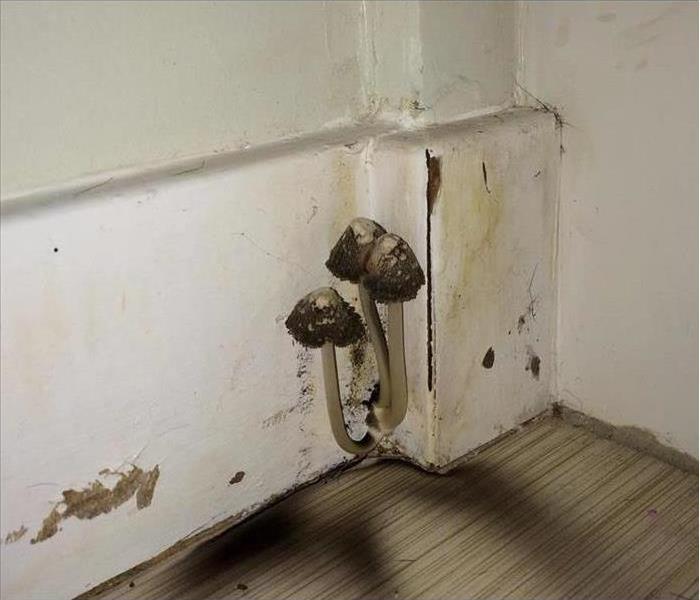 Extreme Mold Growth
Extreme Mold Growth
Water and mold can not only affect the structure of your home, but also your belongings. If your home has suffered damage from a leak or flood, it’s important to check all indoor furnishings and fixtures for signs of mold damage.
SERVPRO of Glendora/ San Dimas understands that your home is more than a structure; your family’s furniture, clothing, keepsakes, and other belongings help transform a house into a home.
Our expertise and “restore” versus “replace” mentality can help you save money while preserving precious keepsakes that can’t be replaced. We pretest your contents to determine what items can be restored back to their condition before the water and mold damage.
We utilize several methods of cleaning your contents, including:
- Dry Cleaning - Used for cleaning light residues or to pre-clean prior to wet cleaning.
- Wet Cleaning - An effective cleaning method for removing moderate to heavy residues.
- Spray and Wipe -Effective for items that can’t withstand wet cleaning.
- Foam Cleaning - Used for upholstery fabrics that might shrink or bleed if wet cleaned.
- Abrasive Cleaning - Involves agitation of the surface being cleaned.
- Immersion Cleaning - Contents are dipped into a bath of the cleaning product.
SERVPRO of Glendora / San Dimas specializes in restoring contents damaged by fire, water, or mold. If you suspect mold growth in your home, call today for a free estimate. -(626) 852-9922
Defense Against Mold Growth
2/25/2019 (Permalink)
Mold can grow anywhere, where there is an accumulation in moisture.
Prompt mitigation is vital to avoid mold growth, which can be visible in as little as 24-48 hours under certain conditions.
The best approach is preventing mold before it becomes a problem. The key to mold prevention is simple: moisture control.
Prevention
- Keep the humidity between 30 to 60 percent
You can measure humidity levels with a moisture meter or by being attentive to potential problem areas in your home.
- Provide for proper drainage away from building foundations
Directing water away from your home with a proper drainage system.
- Regularly inspect plumbing and appliances for leaks
Drying the wet area and restoring it to its original condition before any moisture seeps in.
- Keep gutters and drains clear of debris
Having your gutters cleaned and inspected for any damages, especially after a storm.
- Inspection
Inspecting the roof, windows, and other areas where water might enter the building, and perform necessary maintenance.
Just like keeping your gutters cleaned, you want to inspect your roof, windows, etc., where water can seep through and collect moisture.
- Respond to all water intrusions
Don't hesitate to clean up any water.
Why the Mold Hype?
1/7/2019 (Permalink)
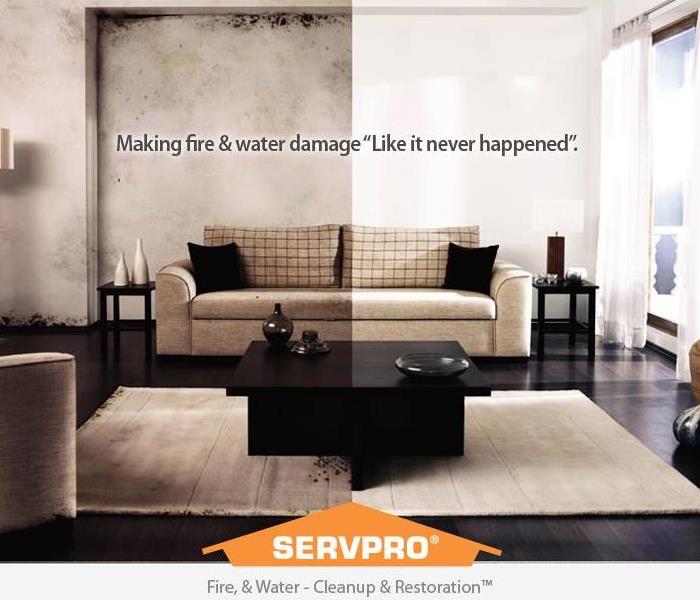 Call SERVPRO of Glendor / San Dimas today to make your mold growth or water damaged home safe to live in again Like it Never Even Happened.
Call SERVPRO of Glendor / San Dimas today to make your mold growth or water damaged home safe to live in again Like it Never Even Happened.
One of the major reason to dry water-soaked materials quickly is to prevent permanent damage caused by fungi. Molds, mildew, and bacteria are responsible for the decomposition of organic materials. Understanding the basics of mold is important if you are in the restoration industry or even a property owner. Next thing you should know is what to do when you find it!
Mold Basics
The typical life of mold begins as a tiny spore. The spore is like a seed but smaller and simpler than real seeds. When something disturbs those spores masses, thousands of mold spores are set free. Airflow carries the spores off and they remain in the air until gravity causes them to settle. A mold spore mass is a lot like a dandelion seed head: when the seeds are released, seeds float everywhere. Spores are built for survival and may or may not start growing immediately. Sometimes they lay dormant waiting for the right conditions for growth. Those conditions include food, temperature, and moisture.
Harmful Effects of Molds
Many different kinds of molds are present in buildings and not all molds are as harmful as others. There research done by The Institute of Medicine found evidence that shows when mold is present in damp indoor situations, people exposed may experience health reactions such as:
- Nasal Congestion
- Sneezing
- Runny or Itchy nose
- Hay Fever
- Sore Throat
- Coughing, Wheezing
Chemical Compounds
Molds produce two types of chemical compounds in which people in water-damaged buildings may be exposed:
- Mycotoxins are poisonous substances that are known to cause health problems.
- Microbial Volatile Organic Compounds (mVOCs) result in unpleasant smells in our homes. These are not known to cause health effects, but odors may indicate a level of mold contamination requiring remediation and are a clue that active mold growth may be present.
If you are living in the Glendora / San Dimas area and have recently experienced water damage to your home or business and want SERVPRO of Glendora / San Dimas to help assess the damage before any mold starts to grow, give us a call and we'll come out to give you an estimate today and even work with your insurance to get the job done right!
5 Things You Should Know About Mold this Summer
6/26/2018 (Permalink)
6/26/2018
As the summer is heats up, it is important to remember that mold does not take a vacation! In fact, the warmer conditions can actually trigger dormant mold spores into active mode.
Here are 5 things to know about mold this summer:
1. Symptoms of mold can include allergic reactions, respiratory problems, and asthma.
2. The way to control indoor mold growth is to control moisture.
3. Fix the source of the water problem or leak to prevent mold growth.
4. Certain molds can grow on wood, paper, carpet, and floods.
5. Try to clean and dry any water or moisture you may find within 24-48 hours. This will help prevent mold!
Remember these 5 facts this summer in order to have a fun and mold-free summer!
Making Your San Gabriel Valley Home Mold Resistant
3/12/2018 (Permalink)
There is no such thing as a mold-proof home. Mold spores exist in the air inside our homes, but we can cohabit peacefully as long as those spores don’t find moisture and start growing. If they do, it’s only a matter of time before mold spreads, and once that happens, it can be difficult to eradicate. While you cannot eliminate mold, you can discourage its growth.
According to the Centers for Disease Control and Prevention, mold growth can exist practically anywhere. All mold needs to thrive is moisture, a food source, and warmth. The “food source” can be any number of household items or materials such as bedding and draperies, shower walls and windowsills, wallpaper and ceiling tiles. Here are some steps you can take to help make your home mold resistant:
- Prevent Moisture- Be sure to reduce moisture in your home whenever you can. For example, keep humidity below 50% in basements, improve outside grading and drainage by keeping gutter clean and soil sloping away from your home, and cover dirt crawl space floors with plastic to reduce moisture
- Ventilate- Poor or missing ventilation fans in damp spaces like baths and kitchens can leave enough moisture behind to sustain a mold problem. Make sure all baths and kitchens are vented by properly sized fans that take moisture outside.
- Store Safely- Keep all storage at least several inches up off concrete floors and away from foundations where dampness can easily seep in.
- Heat Finished Basements- Below grade spaces like finished basements are more likely to become infested and should always be heated to at least 60 degrees, even when not being used.
- Reduce Humidity- Use dehumidifiers to reduce humidity to 30%- 50% and fans to increase airflow in your home, especially if you live in a hot, humid climate.
- Insulate Ducts- Duct systems that carry heated or cooled air throughout your house must be insulated whenever they pass through unheated or uncooled spaces like attics or basements. If not, condensation can form inside the ducts and when combined with dust in the air, can allow mold to grow in the ducts.
- Clean Carefully- Use mold-inhibiting cleaners in the bathrooms and kitchens. Portable air conditioning units should be taken apart and cleaned at the start of every season.
- Fix Floods Fast- If you do have a major leak or flood, quick action can stop mold before it starts. Thoroughly dry soaked carpets and padding, and remove any wet upholstery.
By taking these steps to make your home mold resistant, you’ll avoid the headaches of remediation and repair, as well as the potential health problems mold can cause. If you do suspect mold growth in your home, SERVPRO of Glendora/San Dimas can inspect, assess and remediate your property. CALL TODAY 626.852.9922
Furniture Mold Removal
2/21/2018 (Permalink)
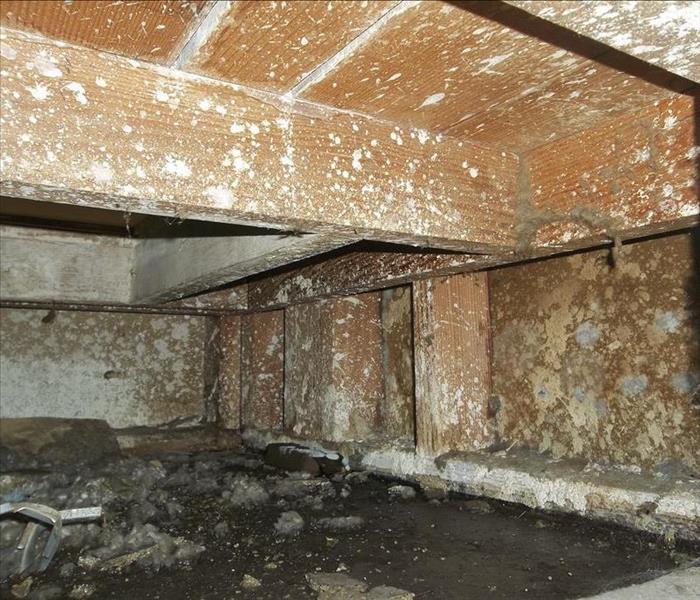 Severe Mold Damage
Severe Mold Damage
Water and mold can not only affect the structure of your home, but also your belongings. If your home has suffered damage from a leak or flood, it’s important to check all indoor furnishings and fixtures for signs of mold damage.
SERVPRO of Glendora/ San Dimas understands that your home is more than a structure; your family’s furniture, clothing, keepsakes, and other belongings help transform a house into a home. Our expertise and “restore” versus “replace” mentality can help you save money while preserving precious keepsakes that can’t be replaced. We pretest your contents to determine what items can be restored back to their condition before the water and mold damage.
We utilize several methods of cleaning your contents, including:
- Dry Cleaning - Used for cleaning light residues or to pre-clean prior to wet cleaning.
- Wet Cleaning - An effective cleaning method for removing moderate to heavy residues.
- Spray and Wipe -Effective for items that can’t withstand wet cleaning.
- Foam Cleaning - Used for upholstery fabrics that might shrink or bleed if wet cleaned.
- Abrasive Cleaning - Involves agitation of the surface being cleaned.
- Immersion Cleaning - Contents are dipped into a bath of the cleaning product.
SERVPRO of Glendora / San Dimas specializes in restoring contents damaged by fire, water, or mold. If you suspect mold growth in your home, call today for a free estimate. -(626) 852-9922
9 Tips to Prevent Mold In Your San Gabriel Valley Home
1/29/2018 (Permalink)
While mold is necessary for the decomposition of organic matter in nature and in the making of brie and penicillin, it can be very dangerous when found in your home or business.
Mold spores can spread easily and cannot be completely eradicated. It can grow in places such as your carpet, clothing, food, paper, and even in places you cannot see such as the backside of the drywall and above ceiling tiles. The presence of mold in your home can also produce allergens and irritants that could compromise your health.
The best approach to mold is preventing it before it becomes a problem. The key to mold prevention is moisture control.
Here are 9 ways to prevent moisture indoors:
1. Identify Problem Areas and Correct Them
Do an audit of your home and decide where the problem areas are. Preventing mold from growing or spreading might be as simple as ripping up carpet in a damp basement, installing mold-resistant products, or repairing damaged gutters.
2. Dry Wet Areas Immediately
Mold cannot grow without moisture so take care of wet areas right away. If you’ve experienced a water loss, remove items that cannot be dried such as bedding, carpets, and furniture. Also, be mindful of everyday occurrences such as wet clothes in the washing machine and wet shower walls.
3. Prevent Moisture with Proper Ventilation
Vent appliances that produce moisture and use AC units and dehumidifiers. Make sure an activity as simple as cooking dinner, taking a shower, or doing a load of laundry doesn’t invite mold by providing proper ventilation in your bathroom, kitchen, laundry room, and any other high moisture areas.
4. Equip Your Home with Mold Resistant Products
If you are building a new home or renovating an old one, be sure to use mold-resistant products like mold-resistant drywall or mold-resistant Sheetrock, and mold inhibitors for paints. Traditional drywall is more susceptible to mold and removal and replacement can be expensive.
5. Monitor Humidity Indoors
The moisture levels in your home should be anywhere in between 35% and 50%. If you reach 60% relative humidity it is best to look for the source of the added moisture and at 70% certain species of mold can be growing.
6. Direct Water Away From Your Home
Slope the ground around your home or business away from the foundation to prevent water from collecting and seeping into the crawlspace or basement.
7. Clean or Repair Roof Gutters
Have your roof gutters cleaned regularly and inspected for damage. Repair them as necessary and keep an eye out for water stains after storms that may indicate a leak.
8. Improve Air Flow In Your Home
Without good airflow in your home, excess moisture may appear on your walls, windows, and floors. To increase circulation, open doors between rooms, move furniture away from walls, and open doors to closets that may be colder that the rooms they are in.
9. Call a Professional
If you aren’t sure how to correct a problem you find, call SERVPRO of Glendora/San Dimas. We provide free inspections to our customers and can help with all of your mold remediation needs.
https://www.mnn.com/your-home/at-home/stories/how-to-prevent-mold-9-tips
Mold Vs. Mildew: What's The Difference?
1/29/2018 (Permalink)
Mold and mildew are both types of fungi that are commonly found in homes. They thrive in moist environments, spread easily, and can live on many surfaces which makes them very difficult to get rid of and clean. If they are not taken care of properly, harmful microorganisms can quickly affect your property, which could result in structural damage.
While mold and mildew are similar it is important to know their different characteristics to help with the cleaning and prevention of these household fungi.
What is Mildew?
Mildew is a specific type of mold. It is usually a thin dusting of a black, grey, or white growth appearing on fabric, upholstery and occasionally walls. The most commonly encountered kind of growth in homes is a grey-black powdery mildew and is easily recognizable. It is most commonly found in bathrooms, kitchens, and basements. To identify mildew growth, check for a musty smell, change in color, and any areas that mildew might have eaten away.
What is Mold?
Mold is a fungus that contains multiple identical nuclei and grows in the form of black or green patches which penetrate beneath the surface of the affected material. It is often the result of a much larger infestation and can appear almost “fuzzy” or even slimy in nature. Mold growth requires moisture which could come from washing, cooking, condensation, or leaks from plumbing. Mold also releases small "spores" into the air.
The key to treating mold and mildew is to remove it from your home immediately. If you find mold or mildew in your home be sure to call SERVPRO of Glendora/San Dimas for all of your mold remediation needs.
5 Myths About Mold
12/20/2017 (Permalink)
When it comes to mold, there is a lot of misinformation told. Even mentioning the word “mold” can cause people to flee in panic. In reality, mold can be a serious problem, but with the right information you can learn to distinguish myth from fact. To help you learn facts from fiction, here are 5 common myths about mold.
Myth #1: “Your house can and should be completely free of mold.
This statement is false on both accounts. Mold spores are apart of the natural environment, and it would be virtually impossible to remove every last spore from your home. Mold is only an issue when its concentration reaches unhealthy levels, typically as large, visible colonies.
Myth #2: “Mold is harmless.”
Even though you can’t completely remove mold from your house, allowing it to grow unchecked is not wise. The health effects of mold are still unclear, and vary person by person, but there is not question that mold can and will damage your personal belongings if allowed to grow on them.
Myth #3: “Once you’ve killed mold, the removal is optional.”
The allergens in mold are still present and can become airborne even when mold is dead. After mold has been killed in your home, it should be fully removed. Care must also be taken when removing the affected areas so that the allergens and mold is not spread throughout the house.
Myth #4: “Bleach kills mold.”
This statement is half true. Bleach can kill certain kinds of mold on non porous surfaces, however, it is not clear if bleach can kill all kinds of mold or mold on porous surfaces such as wood. Using bleach to kill mold also poses its own health risks and could cause further damage if not used correctly.
Myth #5: “A little mold is nothing to worry about.”
If mold is to the point where it is visibly growing on surfaces in your home, there is a problem. Mold is like an iceberg, you generally only see the tip of it while the majority is below the surface. If you see a small amount of mold, you most likely have more growing under the surface.
Because mold can produce allergens and irritants, you will want a professional that has training and experience to properly resolve your mold infestation. If you suspect that your Glendora home or business has a mold problem, SERVPRO of Glendora / San Dimas can inspect, assess and remediate your property.
Learn more about mold and what to do until help arrives by reviewing these mold damage tips.
Concerns With Mold
6/26/2017 (Permalink)
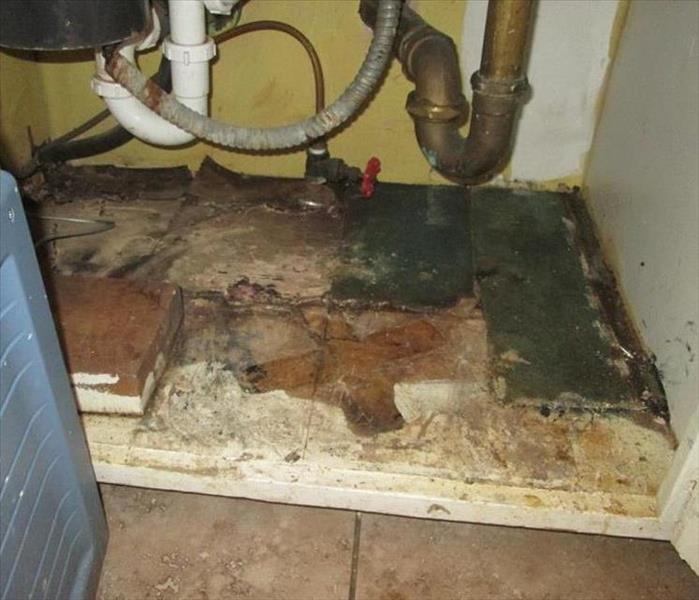 Mold Growing Under a Sink
Mold Growing Under a Sink
Concerns with Mold
Mold spores are in the air everywhere. Inside, mold is at home in moist, dark places—like basements, bathrooms, and behind kitchen appliances—circulating via heating and air-conditioning systems. Outside, mold thrives in the woods, on fallen leaves and dead plants in the garden, and even on some grains and grasses.
Generally, mold and people can coexist without serious concerns. However, there are some groups that need to be concerned with possible problems that come with exposure to mold. The elderly and very young can be more vulnerable to adverse symptoms from mold exposure due to possible lower immunity to allergens, and those with respiratory conditions can be seriously affected when exposed to mold.
MOLD ALLERGY SYMPTOMS
Mold allergies can affect us all year long and bring on nasal allergy symptoms like nasal congestion, sneezing, runny nose, itchy nose, and itchy/watery eyes. And in serious cases, difficulty breathing.
TYPES OF MOLD THAT CAN CAUSE ALLERGIES:
BLACK MOLD
This type of mold tends to grow on building materials like fiberboard and gypsum board, and on paper, dust, and lint. Black mold growth is a result of excessive moisture from extreme humidity, flooding or other types of water damage.
SNOW MOLD
As the snow begins to melt in the spring and the ground warms up, the conditions become perfect for snow mold’s fungal spores to thrive. Snow mold comes in two varieties—grey and pink—and both can bring on nasal allergy symptoms.
LEAF MOLD
Piles of rotting leaves provide the ideal conditions for mold to thrive. Leaf mold generally goes dormant in the winter but begins growing as soon as the weather warms up in the spring.
When mold is discovered inside of a business or residence, SERVPRO of Glendora/San Dimas & Irwindale Baldwin Park will be happy to provide a free inspection to help determine if mold is present and if so, propose steps to eliminate the cause and remove mold from the structure.
Mold Prevention Tips
3/14/2017 (Permalink)
Mold is a common household problem, developing in warm, damp environments. Mold can be colored green, purple, white, and orange. While mold plays an important role outside in the environment, breaking down dead plants, mold is unwelcome in homes.
Showers and bathrooms are a common location for mold to grow, but it is possible for mold to grow anywhere in a home. Mold can come inside a home from an outside growth through inadequately sealed windows or doors. Mold spores cannot be eliminated entirely, but they will not grow if the environment is dry and well ventilated. Mold growth can be prevented by ensuring if water damage occurs, clean up occurs quickly. Using air conditioners during humid seasons and exhaust fans in kitchen can help prevent mold from growing.
Other areas to monitor moisture to prevent mold growth: exterior walls and surfaces in need of insulation where condensation can build, air conditioner drip pans, check for leaks around refrigerator, ensure crawl spaces are well ventilated, and check for leaks around a tub.
These are a few simple tips for making sure mold is not growing in your home. If you do discover a mold growth, SERVPRO of Glendora/San Dimas provides mold remediation services for all types of residential and commercial properties.
http://www.medicinenet.com/mold_exposure/page5.htm
http://www.webmd.com/women/home-health-and-safety-9/mold-mildew?page=2
Spring Cleaning Prevents Mold
2/28/2017 (Permalink)
Spring cleaning often means a “deep clean” of the long forgotten areas of our homes. We clean closets, vacuum around base boards, and replace air filters. Could there be other areas of your home needing cleaning that are being missed? Possibly areas of mold growth you can help prevent? Here are a few tips for your yearly spring cleaning to make it as profitable as possible.
- Cabinets in a kitchen can accumulate grease build up, especially those over a stove area. There are products available that offer cleaning and rejuvenating of cabinets, available at a local home improvement store.
- Dishwashers, while serving to clean dishes, need to be cleaned as well. Food build up can occur, leaving an odor and poor quality washing. To clean your dishwasher, first check manufacture guidelines to see if there are details of areas needing to be emptied of debris or specific solutions to use. A common way of cleaning a dishwasher is to run a cycle without dishes and a specialty cleaner instead of dish detergent. Mold can build up in crevices.
- Ovens in kitchens can begin to smell of burnt food, signaling it is especially time for a cleaning. House Beautiful suggests first chipping away old food, then, spraying an oven approved cleaner, finally, wiping clean of all materials and grime.
- Clean your cleaning tools! Brooms often accumulate annoying dust bunnies. To ensure your floors are being swept as well as possible, dip brooms in warm, soapy water and stir around until dust bunny’s release. Another option is using the hose of your vacuum to remove debris in a broom and empty hose when finished.
- When was the last time your carpets were cleaned? Carpet cleaning is important not only for the look of your carpet but for the removal of dust, dirt, gasses, and other debris not easily removed by a household vacuum. Carpets should be cleaned once a year, as waiting until they appear dirty may mean never fully restoring carpets. SERVPRO of Glendora/San Dimas provides a variety of carpet cleaning services.
Kids and Germs
1/26/2017 (Permalink)
Kids are exposed to germs every day. Germs are part of life and building immunity, but germs can also bring unnecessary sicknesses and overexposure to contaminants like E.coli. Here are a few common places germs live that should be considered for weekly disinfecting.
Remote controls and other small electronics: Hands often aren’t washed before touching small electronics. Electronic surfaces house germs and after a few days will be holding a variety of germs from a variety of hands and places. Disinfect frequently.
Backpacks: Where does your child’s backpack sit each day? Classroom floor? Cafeteria floor? Public restroom floor? Backpack surfaces hold onto germs. So, if upon arrival home the backpack is placed on a counter, bed, or couch, these germs are being transferred to new surfaces. Backpacks should have a designated area, especially away from kitchen counters.
Sinks: Faucets, soap dispenser, or other surfaces touched before hands are cleaned should be disinfected.
Fridge handles: And other places where towels hang collect all the germs on the towel from cooking and dishes, then are left to accumulate on handles. The fridge handle is often the middle ground between food and eating and should be given frequent disinfecting.
http://www.webmd.com/women/home-health-and-safety-9/places-germs-hide
http://www.goodhousekeeping.com/home/cleaning/g4124/gross-things-kids-touch/
http://www.goodhousekeeping.com/home/cleaning/a37762/how-a-microbiologist-who-studies-germs-cleans/
San Dimas Extensive Mold
1/25/2017 (Permalink)
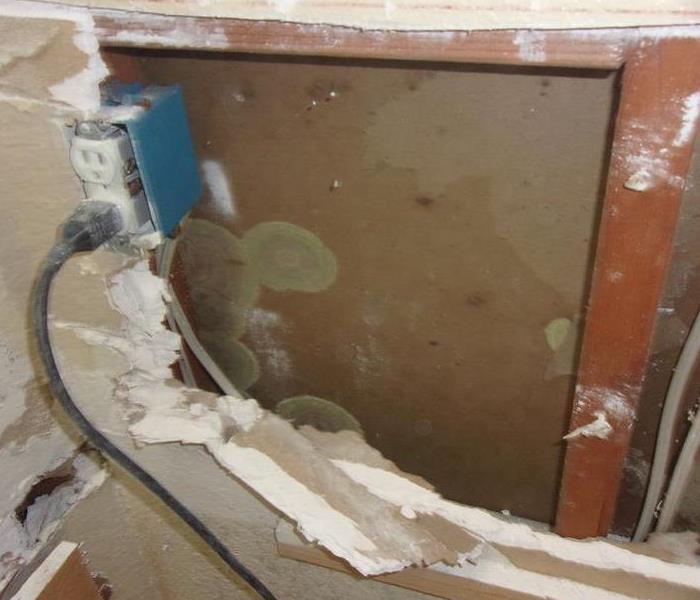 Mold resulting from water damage in San Dimas
Mold resulting from water damage in San Dimas
A San Dimas resident experienced water damage resulting in hazardous mold. The water damage affect the San Dimas home's living room, bathroom, and vanity area. SERVPRO of Glendora/San Dimas was called to provide mold remediation and water damage services.
The crew hauled away all wet and mold invested materials, including drywall, flooring, and wood trim. The SERVPRO of Glendora/San Dimas crew set up containment of a barrier with airlock between the affected area of the San Dimas home and the unaffected area.
The crew removed pieces like the toilet, sink, and medicine cabinets in order to reach the water damaged area and insure drying. The mold affected areas were carefully treated and sanitized and an air scrubber was set up. Hazardous mold affected material was disposed of properly by the Glendora/San Dimas crew. The home was restored from the water damage and extensive mold by the crew and the San Dimas resident's home was cleared after a mold clearance test by a third party.






 24/7 Emergency Service
24/7 Emergency Service

